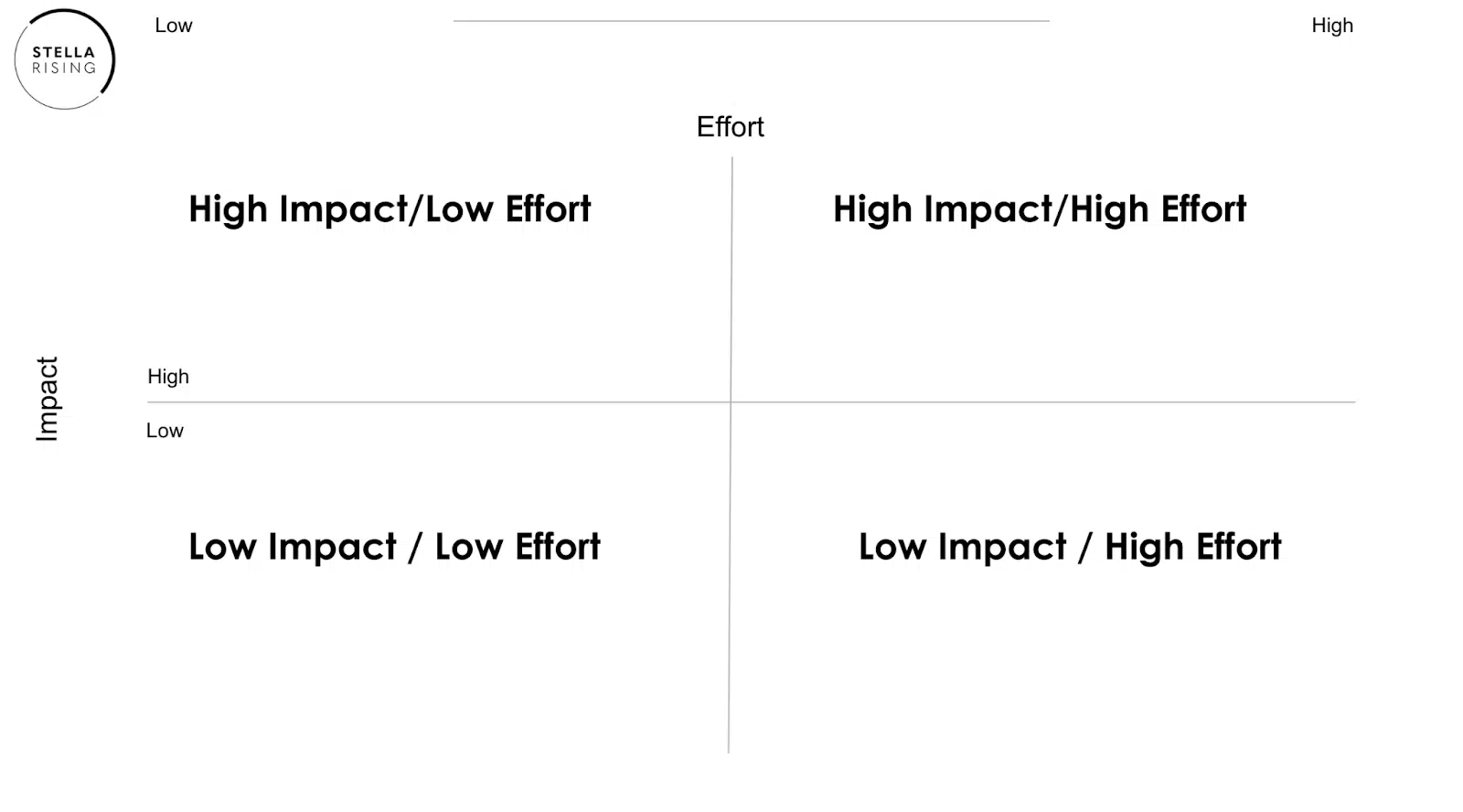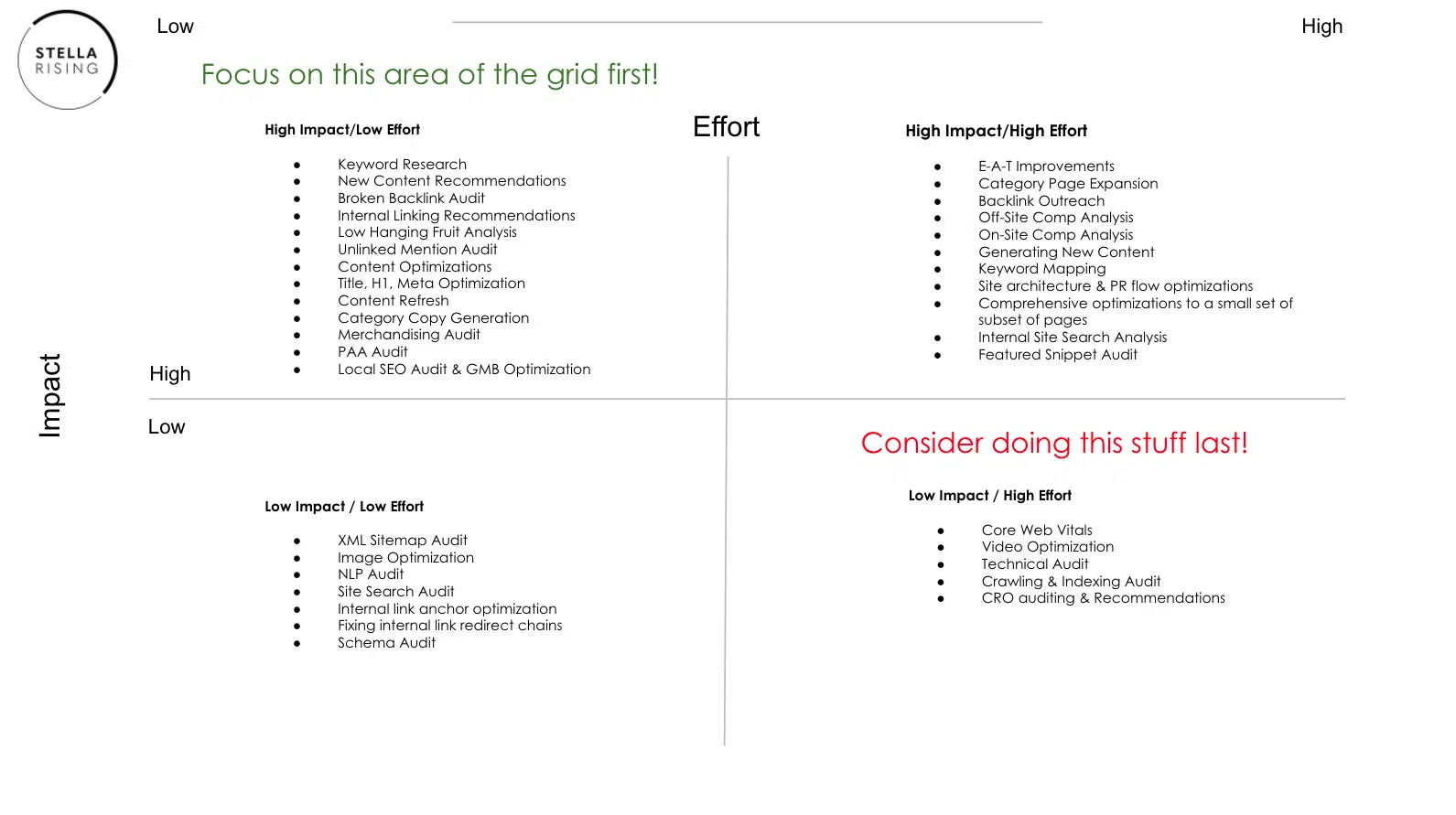Many SEO professionals have been asked by managers or clients, “How long does SEO take?”
Usually, the answer is “Somewhere between 4-12 months.” In some cases, it can take as long as 24 months to see a significant return on investment.
This article discusses ways to get SEO results faster through what the late and great Hamlet Batista called “agile SEO.”
The need for speed
Businesses want returns on their marketing investment sooner rather than later, especially given ongoing supply chain issues, a looming economic downturn and increased labor costs.
Getting results faster than others gives you a competitive edge whether you do SEO in-house or as an agency partner.
Stop doing checklist SEO
One common mistake SEOs make is practicing “checklist SEO.”
This method assumes that to have a well-optimized site, you must check all the boxes in an exhaustive list of best practices and site diagnostics. It also implies that all sites need the same work, which is often untrue.
Checklist SEO is generally not a great approach to SEO. You always need to consider the varying impact and difficulty of each box you’re seeking to check off so that you can prioritize effectively.
Instead of checklist SEO, use the SEO Eisenhower grid
The SEO Impact Eisenhower grid is something our agency developed to prioritize client SEO tactics and efforts based on their expected difficulty and impact. Focusing on work that has proven to be impactful is critical for accelerating client growth.
Make your own SEO Impact Eisenhower grid to better understand what work you should focus on.
The grid consists of four quadrants:
- Top: Higher-impact items.
- Bottom: Lower-impact items.
- Left: Lower-effort items.
- Right: Higher-effort items.
What items would you place in the top left and right (high impact)?
What items would you place on the bottom (low impact)?
Look at the bottom and ask, do we even need to do all of these things in the first 3-6 months of this campaign?
You should plan to examine all opportunities over a year or so, but focusing on high-impact items first will help you achieve faster SEO results.
In this exercise, the aim is to identify those high-impact, lower-effort items and address those first.
Add any ideas you come up with that may be helpful, even if they are higher effort or lower impact, but consider saving them for later on in your SEO campaign.

Many SEOs start with an exhaustive technical and full site audit. While this sounds like a good plan, it may not be the best approach in most situations.
Many smaller sites built on Shopify, WordPress or other common CMS platforms have a limited number of technical issues. Their issues are often the same and can be identified and addressed without a full audit.
Sometimes the things we find in technical audits are “nice to haves” and align with best practices but are often difficult to implement and may not have a measurable impact on every website.
Technical SEO is critical for larger websites and some smaller sites. However, it’s rarely the first thing you should focus on. The exception is when there are indexing or crawl ability issues that would prevent on-page optimization or new content creation from being impactful.
Often, the more technical recommendations that require development time aren’t implemented or sit in a queue for months.
I’m not saying that technical audits are worthless. Quite the contrary.
You should absolutely do that type of work on any site you are trying to help grow. But always start with low-effort, high-impact initiatives.
For example, unless the site is not being crawled at all or is set to noindex, you’d probably get more lift out of doing keyword research, title and meta optimizations and creating new content than you would out of working on fixing a bunch of tech debt like old redirected internal links or optimizing page speed.
Why do so many SEOs start there?
The graphic below exemplifies what we have listed in our SEO Impact Grid based on the deliverables we execute at our agency. These are examples of tactics and their relative effort and impact. These are meant to serve as examples and may differ for every site or industry.

In this example, I was also thinking of what we know to be a direct ranking factor through our own experience or what Google stated is a confirmed ranking factor. Sometimes, that also means critically examining what Google has said about various factors.
For example, Core Web Vitals as a ranking signal. Google beat their drum about this like it would shake up the SERPs in a big way, but the impact has not been that large. Algo-watchers like Glenn Gabe have some interesting data on the true impact.
Now that the Page Experience Update for desktop is complete, here is some data that supports a very lightweight ranking signal. Let’s start with a site that has terrible desktop CWV scores. No change in trending at all during the rollout. pic.twitter.com/5L0AhX4frc
— Glenn Gabe (@glenngabe) March 3, 2022
Implement SEO campaigns faster
One of the other places I see SEOs stumble is not creating the recommendations but implementing them on the website.
We recently published a guide to SEO implementation, which provides a framework for presenting and tracking implementations. If you have already collected your recommendations, check out that guide on implementing them.
Whether your SEO strategies are high or low effort on the impact grid, they will only be impactful if you can implement the recommendations – which requires team buy-in, developer support or a powerful SEO implementation tool.
Pioneers like Baptista and even Stephan Spencer have been using tools and tech to modify clients’ sites without needing dev support for a long time. Since those days, many tools have come to market that enable SEOs to implement SEO changes either on the edge of the cloud or in the DOM.
Tools you can use to implement SEO changes:
- SEO Scout: Uses a pixel to modify DOM. Is designed for SEO “tests” but you can leave them there and benefit from the changes.
- SearchPilot: Requires server-side setup to use service workers / CDN but delivers your changes to the server-side HTML as well as client-side.
- seoClarity: This SEO execution platform automates and accelerates SEO tasks, enabling enterprises to fix critical on-page issues, optimize content and increase agility without the need for developers, ultimately boosting organic traffic and revenue.
- RankSense: An SEO automation tool designed to implement fast and scalable SEO changes, enabling users to optimize thousands of pages effortlessly, track performance and achieve significant traffic growth in weeks without relying on developers.
Do agile technical auditing
In the world of web/app development, there are two models for how teams work: waterfall and agile. The Agile methodology is built around sprints. In SEO, we have traditionally worked more in a waterfall approach, where a bunch of recommendations are dumped on a client or dev team’s desk while we move on to other audits or optimizations.
The waterfall approach may be simpler than Agile, but it sacrifices the ability to prioritize high-impact changes. Try a more agile approach, where you constantly crawl and identify key priority fixes.
Screaming Frog’s Issues tab is a great place to source a list of prioritized recommendations. Try working through just one or two of these per sprint with your clients. Thinking back to the impact grid, technical SEO doesn’t have to be monumental if you take an Agile approach that tackles one step at a time.
At our agency, we have started working with many clients in this way: focusing on just one key task or implementation from our audits. We provide project management and implementation support for that one task, then move on to the next.
Initiative-based reporting
Once you have gotten your client or in-house team to implement something, your job is to turn into a cheerleader.
Create a mini case study of what you implemented and the impact that you saw. This helps rally teams to implement similar changes but also motivates them to implement your other recommendations.
When internal stakeholders or client teams can see the impact of your individual recommendations, something magical happens. They become excited to implement more of them. The time it takes to implement changes diminishes, and your impact grows over time.
If your compelling data-filled story doesn’t help with implementation, you can always use the implementation tools we mentioned above to get them done.
Do SEO testing
SEO testing was previously reserved for enterprise organizations like eBay, which could invest in their own custom solutions. However, with the growth of cloud-based hosting or content delivery network (CDN) solutions like CloudFlare, new solutions like RankSense and Search Pilot came to fruition. These platforms enable you to implement and test SEO changes.
SEO testing helps you get SEO results faster by showing you exactly what changes will have a positive impact vs. those that may not or may even have a damaging impact. Knowing what changes will yield positive results before using developer or team resources to implement them can help you avoid wasted time and get to results faster than stabbing in the dark.
Accelerating your SEO efforts
We all know that SEO takes time. However, that doesn’t mean you or your clients need to wait months for anything meaningful to happen.
SEO testing, tools for implementation and a strong understanding of the most impactful work are critical components of an agile SEO strategy that gets results. With the above framework for pushing on low-hanging fruit first and bigger wins later, you’ll be well-positioned to get SEO results faster than ever before.
Contributing authors are invited to create content for Search Engine Land and are chosen for their expertise and contribution to the search community. Our contributors work under the oversight of the editorial staff and contributions are checked for quality and relevance to our readers. The opinions they express are their own.




